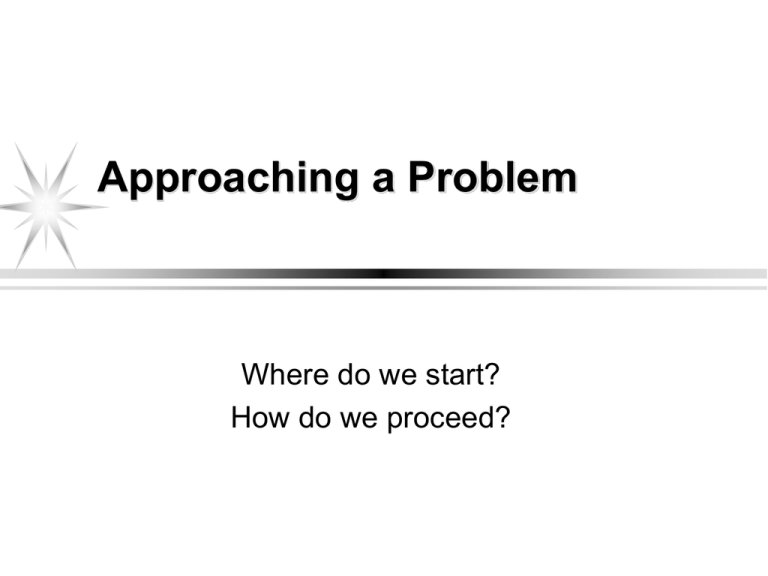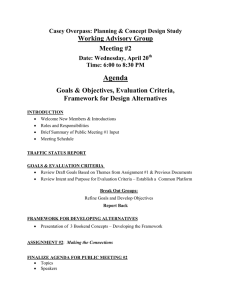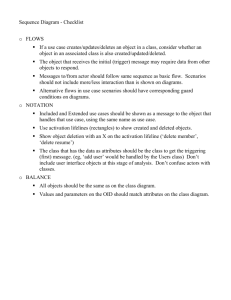Approaching a Problem Where do we start? How do we proceed?
advertisement

Approaching a Problem Where do we start? How do we proceed? Where Do We Start? Start with the requirements Use-case analysis to better understand your requirements Capture your goals and possible constraints Environmental assumptions Find actors and a first round of use-cases Start conceptual modeling Conceptual class diagram Interaction diagrams to clarify use-cases Activity diagrams to understand major processing How Do We Continue? Refine use-cases Possibly some “real” use-cases Refine (or restructure) your class diagram Based on your hardware architecture For instance, client server Refine and expand your dynamic model Using interface mockups Until you are comfortable that you understand the required behavior Identify most operations and attributes How Do We Wrap Up? Refine the class diagram based on platform and language properties Identify all operations Navigability, public, private, etc Class libraries Not the trivial get, set, etc. Write a contract for each operation Define a collection of invariants for each class Implement Process Overview Transition Inception Elaboration Construction n Many iterations Construction 3 Construction 2 Inception Elaboration Construction Construction 1 Transition Requirements Analysis Defining the WHAT Requirements Specify functionality model objects and resources model behavior Specify data interfaces type, quantity, frequency, reliability providers, receivers operational profile (expected scenarios) stress profile (worst case scenarios) Requirements Specify interfaces Control interfaces (APIs) User interfaces - functionality and style Hardware interfaces Specify error handling Identify potential modifications Requirements Identify necessary constraints performance, security, reliability Identify areas of risk alternatives to be explored Specify validation plans Specify documentation to be provided Analysis Principles Document reason for specific requirements Prioritize requirements High, medium, low Ignore implementation details Need to know feasible solutions can be developed If feasibility is a concern, then propose alternatives to be explored Be prepared to change Reviewing a requirements document Is it ambiguous? Is it consistent? Is it complete? Carefully define terms and use these terms Vague requirements Omitted requirements Is it verifiable? Is it realistic? Does it plan for change? Does it not overly constrain the problem? Have alternatives been considered and explored? Is it clearly presented? Precise, concise, clear diagram complex objects and behaviors Is it what the customer wants? Why is requirements analysis difficult? Communication: misunderstandings between the customer and the analyst Analyst doesn’t understand the domain Customer doesn’t understand alternatives and trade-offs Problem complexity Inconsistencies in problem statement Omissions/incompleteness in problem statement Inappropriate detail in problem statement Why is requirements analysis difficult? Need to accommodate change Hard to predict change Hard to plan for change Hard to forsee the impact of change First Law of Software Engineering “No matter where you are in the system lifecycle, the system will change, and the desire to change it will persist throughout the lifecycle.” Reasons for changing requirements Poor communication Inaccurate requirements analysis Failure to consider alternatives New users New customer goals New customer environment New technology Competition Software is seen as malleable Changes made after the requirements are approved increase cost and schedule Requirements Products Specification document Agreement between customer and developer Validation criteria for software Preliminary users manual Prototype If user interaction is important If resources are available Review by customer and developer Iteration is almost always required Analysis: Steps to follow Obtain a problem statement Develop use cases (depict scenarios of use) Build an object model and data dictionary Develop a dynamic model state and sequence diagrams Verify, iterate, and refine the models Produce analysis document Use Cases High-level overview of system use Identify scenarios of usage Identify actors of the system: External entities (e.g., users, systems, etc.) Identify system activities Draw connections between actors and activities Identify dependencies between activities (i.e., extends, uses) Analysis: Object Model Organization of system into classes connected by associations Shows the static structure Organizes and decomposes system into more manageable subsystems Describes real world classes and relationships Analysis: Object Model Object model precedes the dynamic model because static structure is usually better defined less dependent on details more stable as the system evolves Analysis: Object Model Information comes from The problem statement and use cases Expert knowledge of the application domain Interviews with customer Consultation with experts Outside research performed by analyst General knowledge of the real world Object Model: Steps to follow Identify classes and associations nouns and verbs in a problem description Create data dictionary entry for each Add attributes Combine and organize classes using inheritance Analysis: Dynamic model Shows the time dependent behavior of the system and the objects in it Expressed in terms of states of objects and activities in states events and actions State diagram summarizes permissible event sequences for objects with important dynamic behavior Dynamic Model: Steps to follow Use cases provide scenarios of typical interaction sequences Identify events between objects (Sequence Diagram) Prepare an event trace for each scenario Build state diagrams Match events between objects to verify consistency Analysis: Iteration Analysis model will require multiple passes to complete Look for inconsistencies and revise Look for omissions/vagueness and revise Validate the final model with the customer Object Model: Four main system objects or classes Controller object might be made up of several controllers is the brains of the system. Takes input from the sensors and gives instructions to the actuators. Sensor object environmental objects that gives information to controller. Can be passive (thermometer) or active (button).



